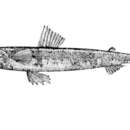Trophic Strategy
provided by Fishbase
Occurs in inshore waters of the continental shelf and slope (Ref. 75154).
- Recorder
- Auda Kareen Ortañez
Biology
provided by Fishbase
Prefers to live in deeper water (Ref. 44036).
Comprehensive Description
provided by Smithsonian Contributions to Zoology
Synodus kaianus (Günther, 1880)
Saurus kaianus Günther, 1880:50 [Arafura Sea].
Synodus kaianus.—Gilbert, 1903:588.
MATERIAL EXAMINED.—Holotype: BMNH 1879.5.14.594, ARAFURA SEA. WESTERN AUSTRALIA (1): AMS (uncataloged). SOUTH CHINA SEA (1): USNM 217734. JAPAN (11): USNM 217779 (10); CAS 32266 (1). HAWAIIAN ISLANDS (11): USNM 126556 (4), 217617 (2); CAS 8539 (3), 30139 (1), 30155 (1).
DIAGNOSIS AND COMPARISONS.—A species of Synodus with the following combination of characters: dorsal-fin rays (branched and unbranched) 10–13 (usually 12); anal-fin rays 10–11 (usually 11); pored lateral-line scales 59–63 (usually 60); transverse scale rows 3.5/5; vertebrae 58–63 (usually 60); combined dorsal and anal procurrent rays 23–28; anterior palatine teeth not longest and not in a discrete group; peritonel spots none; peritoneum black; posterior pelvic process narrow; tip of lower jaw fleshy.
Synodus kaianus differs from all other Indo-West Pacific Synodus except S. macrops by its black peritoneum. The vertebral count of S. kaianus is much higher than that of S. macrops (58–63 vs. 51–55).
DESCRIPTION (holotype plus range).—Dorsalfin rays 12(10–13); anal-fin rays 10(10–11); pectoral-fin rays 13(12–13); pelvic-fin rays 8; procurrent rays 24(23–28), dorsal 13(12–15), anal 11(11–13); lateral line continuous 60(59–63) pored scales; scale rows above lateral line from dorsal origin 3.5; scale rows below lateral line to anal origin 5; predorsal scales 18(16–18); rows of cheek scales 5(4–5); vertebrae 60(58–63); peritoneal spots none.
Percentages of Standard Length: Mean (range): head length 26.6 (25.1–30.2); snout length 7.8 (7.0–9.2); upper jaw length 17.3(15.8–19.7); diameter of bony orbit 6.7(5.4–8.3); least width of bony interorbital 3.1 3.7); snout to dorsal origin 43.7(40.0–47.8); snout to adipose origin 87.1(81.9–89.9); snout to anal origin 79.0(74.4–82.8); snout to pelvic insertion 37.5(34.8–40.2); snout to pectoral insertion 28.0(25.9–30.7); first-dorsal-ray length 8.9(7.6–11.2); longest-dorsal-ray length 14.5(10.9–17.8); pectoral-fin length 13.9(12.0–15.7); pelvic-fin length 17.9(14.4–22.4); dorsal-fin base 11.7(10.4–14.3); anal-fin base 8.7(7.2–10.1); based on 15 specimens 73.5 to 209.5 mm SL.
Body fusiform, head somewhat depressed, caudal region a little compressed. Large cycloid scales on body, cheeks, and operculum, postoral portion of cheeks scaly. Snout sharply pointed, slightly longer than broad; the anterior nostril on each side bearing a short, truncate flap, extending only slightly beyond edge of nares when depressed anteriorly. Interorbital space concave, occipital region bony. Palatine teeth in an elongate V–shaped pad, teeth pointing backwardly, those in front not largest and not in a discrete group. Lingual teeth well developed, those on free end of tongue largest and about 30 in number, free end of tongue narrow anteriorly (only 2–3 teeth across). Teeth caniniform, larger teeth with arrow-shaped tips. Pectoral fins not reaching a line from base of pelvic fins to origin of dorsal fin. Outer pelvic ray unbranched and short, fifth branched ray (sixth ray) longest. Posterior bony process of pelvic girdle narrow. Peritoneum black.
COLOR PATTERN.—Dorsum uniformly dark. Three large blocks of pigment just below lateral line, first below origin of dorsal fin, second slightly posterior to dorsal fin, third below adipose fin origin. Between each of the larger blocks of pigment are three patches, the middle patch of the three larger than outer two. This pigment pattern is unique to this species and makes S. kaianus easily recognized. Fins unmarked.
DISTRIBUTION, HABITAT, AND GEOGRAPHIC VARIATION.—This species has been reported from the South China Sea, Timor Sea, Arafura Sea, Japan, and Hawaii (Figure 41). The depth of capture (270–300 m) of the South China Sea specimen indicates that this species may prefer deeper water than most other Indo-West Pacific species, and that depth preference might account for its scarcity in collections and its scattered distribution records.
The specimens examined from Hawaii generally have higher vertebral, dorsal-fin ray, anal-fin ray, and procurrent caudal-fin ray counts than those from Japan. The means of the Hawaiian specimens respectively are 62, 12.3, 10.8, and 25.3, whereas the Japan specimens are 59.5, 11.3, 10.4, and 24.3. The specimen from the South China Sea has a vertebral count of 62. The holotype from the Arafura Sea has 60 vertebrae. The count differences between the Hawaiian and Japan material suggest that two species may be involved, but since there is overlap in these counts, I have refrained from separating them. No other characters were found with differences between these two populations.
- bibliographic citation
- Cressey, Roger F. 1981. "Revision of Indo- West Pacific lizardfishes of the genus Synodus (Pisces: Synodontidae)." Smithsonian Contributions to Zoology. 1-53. https://doi.org/10.5479/si.00810282.342
Gunther's lizard fish: Brief Summary
provided by wikipedia EN
The Gunther's lizardfish (Synodus kaianus) is a species of lizardfish that seems to live mainly in the Pacific Ocean this fish species is extremely rare and so far only one specimen has been found in Hawaii.
- license
- cc-by-sa-3.0
- copyright
- Wikipedia authors and editors

